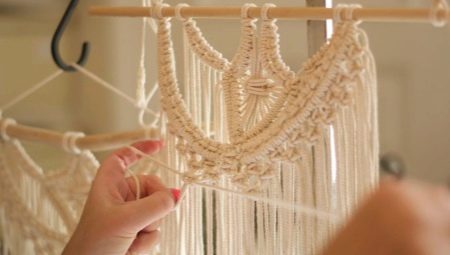Mankind has invented a large number of nodes, but in the macrame technique only a part of them is used. Combinations and repetitions of their various types allow you to create original products: bracelet, flower pots, panels. The basis for all these products are different threads.
Features
The simplest nodular weaving patterns have been known since antiquity, when people learned to use nodules to create clothing and household items. Its historical beginning and Macrame technique was developed in ancient China in the middle of the 8th century. Macrame was also used in medieval Europe, as similar works can be seen on the canvases of Renaissance artists, but Extraordinary popularity of this technique came only at the beginning of the 20th century..
Planters, carpets, lampshades, made by weaving threads, were used not only in home interiors, but also were decorations in cultural and public catering establishments.
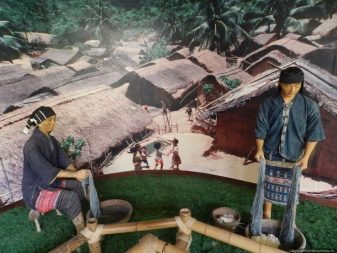
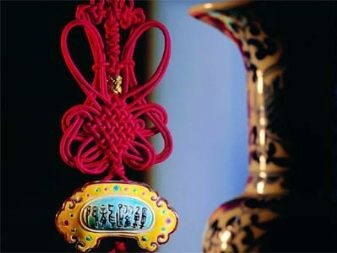
The main tools that are useful in weaving macramé:
- scissors;
- a small pillow;
- pins
- Crochet hook;
- glue.
Pillow for weaving sometimes they are replaced with a piece of polystyrene foam, but often the craftswomen also use special planks covered with a soft cloth or foam rubber. Macrame threads long and durable are used, and clear reliefs are obtained by twisting these threads. If you need to continue weaving, and the thread is over, then it can be lengthened. For beauty products applied color material or finished products are stained, but this approach is a rare occurrence in macramé.
Glue is needed to process some threads, for example, silk, so that the thread does not unfold during operation. For weaving regular wool yarn can be used, but the threads in its composition should be very tough and durable.
The nodes in the macram need to be twisted tightly, and if the material is weak, then it will constantly tear.
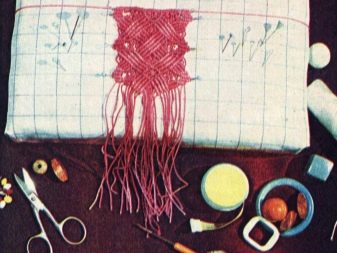
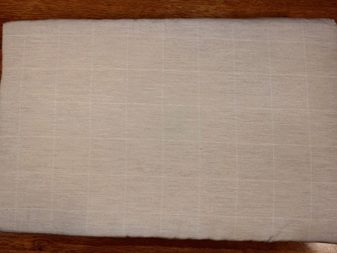
Simple nodes
The basic knots of macrame allow you to perform simple products that can be turned into the basis of a beautiful interior decoration or jewelry. Before you begin, you should understand the basic concepts:
- the basis is the thread on which the nodes will be fixed;
- working thread - the one used to create the node;
- for convenience, all threads need to be fixed on something, so this part is also called the basis;
- fastening the thread on the base is called a lock and is performed by an element outward or inward of the product.
Macrame nodes are divided into basic and additional. The first elements are the basis for many variations of patterns, consider some of them.

Rep node
Its structure similar to a single knot. In this technique, it is one of the main ones. By forming such nodes sequentially, you can get a volume cord, which is called a brid. Breeds are divided into horizontal or diagonal.
The horizontal brid is obtained from two working threads that are parallel to the base. The thread for the diagonal brid is at an angle. The combination of horizontal and vertical foundations allows you to embody interesting geometric patterns.
Rep item can be performed vertically or horizontally. The first option involves the use of the first thread in a row as a working one. The horizontal type knot assumes the use of the second thread in the row as the main one. If you correctly use a combination of these nodes, you can get beads of various sizes, which are used to create jewelry. They are fixed with a beautiful twisted thread and get a simple but beautiful decoration.
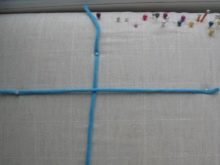
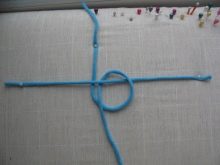

Flat knot
Used to create home decoration, looks direct. A node is fundamental in creating many flat elements. Flat knots are executed on the left or right side work. A series of one-sided knots creates a twisted cord that can be used to make curtains or jewelry. As a variation of the design, a double flat unit can be used.
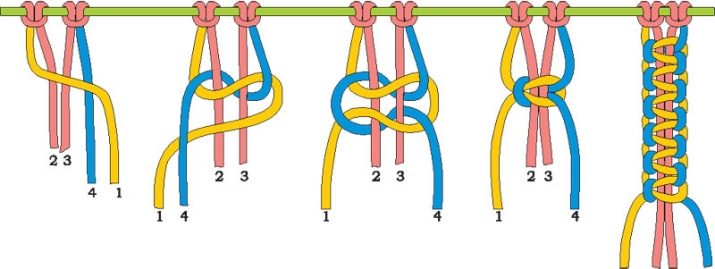
Hercules knot
Such an element was used everywhere before the advent of nodular weaving technique. In ancient Greece, it was the main unit in the manufacture of clothing. Today needlewomen successfully use it to create beautiful panels, furniture and even carpets.
To weave such an element, use two threads attached to the base. The thread on the left is laid horizontally with the hanging end on the right. The second thread is laid on top of this base, and the end of the thread is threaded to the left in the loop obtained. The right thread is stretched in a horizontal position so that its end remains on the left, and the left thread is passed under this hanging part. Now the left thread should be on the horizontal base of the right thread, and its end must be threaded into the resulting second loop.
By completing these steps, the Hercules knot can be tightened. The same knot can be obtained from four threads, and its appearance will be similar to the decorative square knot “Frivolite”.
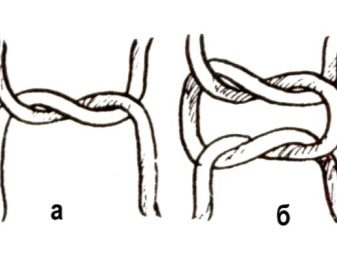
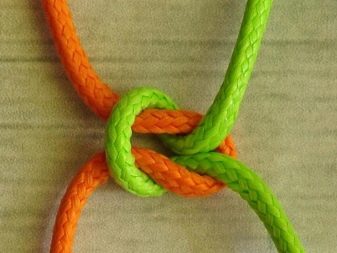
Chinese species
Each Chinese macrame knot has a shape that has its own meaning. In the weaving technique red threads are often used, which indicate prosperity and well-being.
"Lotus"
A node that runs in a circle, while working there are no warp or warp threads, as they are all used for the pattern. Nodes are stacked clockwise or counterclockwise. This technique was successfully used in marine practice, since the resulting cord came out very durable.
For weaving, you can use a variety of materials - rope, leather, wool.
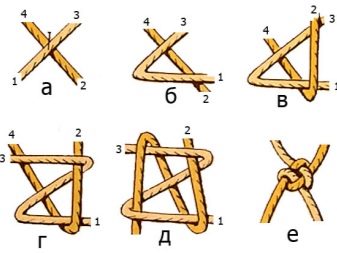
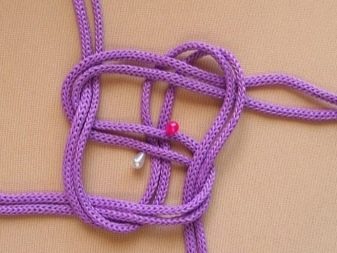
Chess
This macrame element includes square knots to be staggered. As a result of weaving, a canvas with a beautiful pattern is obtained, which is used to create baskets, bags and even hammocks. When creating the main square element, 4 threads are required, therefore, for the fabric to be prepared, you need to select the number of threads that is a multiple of this number. For training in weaving, satin threads or thick nylon cords are used. Products with the elements of "Chess" are interesting and unusual.
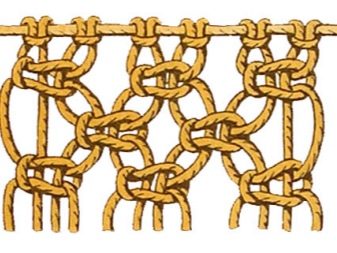

"Button"
A knot that is often used when creating jewelry. Finished products look more elegant if you alternate nodes with beads. This element is noteworthy in that a loop is formed at the top, which can be left, but can be tightened.
The main Chinese nodes are perfect symmetry and identical appearance on both sides of the product.
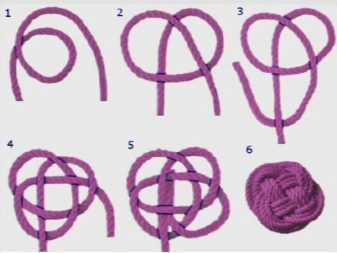
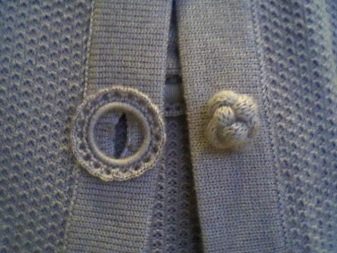
Decorative options
Especially beautiful knots are used to create individual products or as an element in a common canvas.
"Tatting"
A knot that is used to decorate part of the product when two threads alternately braid an object from the main threads. The main difference in the weaving technique is to fix the contours of the pattern with a special loop. For the “Frivolite” chain, you can use either two or four threads. In single weaving, one main rope is used, which is braided by the second, resulting in beautiful patterns.
“Tatting” is a simple but very elegant weaving, in order to complete it, it is enough to attach two threads to the base or one, but folded in half. The left thread rotates around the right upward movement. It turns out a loop in which the left thread is passed. Elements are tightened in turn, as a result the whole "column" of knots turns out. "Tatting" of the four foundations is formed when alternating the first and last threads that are tied on a central base - threads folded in pairs.
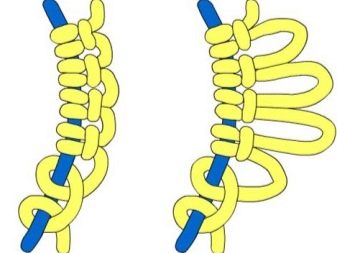
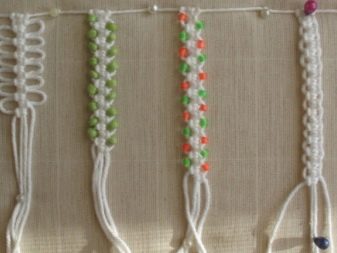
"Josephine"
A wide knot that can be used to visually highlight part of the canvas. A chain of such nodes is also suitable for creating decorative belts.
The “Josephine” knot symbolically means prosperity and longevity, it is also called the knot of happiness and good luck, therefore jewelry stores with a similar set of chains are used by shopkeepers.
For beginners, it is difficult to perform, as it is necessary to achieve uniform thread tension, the only way it turns out a beautiful product. For "Josephine" you can use one thread, from which the left-side loop is made. In this case, the second end of the thread is laid first on this loop, and then is threaded under the first end. The same thread is threaded first under the left loop, and then under its second end - this way the right loop is obtained. The resulting complex element must be aligned by pulling all the finished loops.
The macramé knots “Josephine” and “Frivolite” are complex, but they will turn out if you carefully study the patterns of weaving flat and square knots.
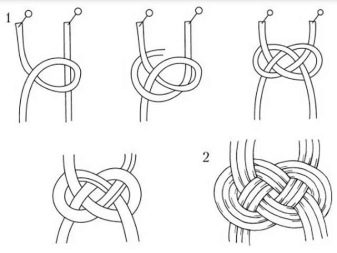
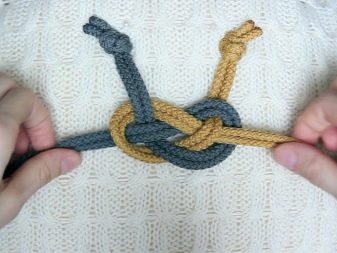
Pico
These are the loops of work threads that are obtained between simple elements. For example, they are often used between several tatting elements. In addition, "Pico" is the basis for stringing beads. This node is difficult to execute accurately, therefore strips of cardboard are useful for its creationused as a ruler.
When weaving, one element is first tied, then a ruler is placed under it, while the working threads should be on top of the warp. The next item is tied under the ruler, and the ruler is then removed.

"Berry"
A popular element in macram, which is also called "Pea", "Nest" or "Tubercle". The basis for this element is a chain made of square knots. To get the “Berry”, the warp threads need to be lifted and threaded over the first knot located at the beginning of the work.
The base must be stretched down to the wrong side until the last and first nodes are together. Fixation of "Berry" is possible with the same square knot.
If you use several multi-colored ropes in this method of weaving, you will get an elegant cord that can be used in various products.
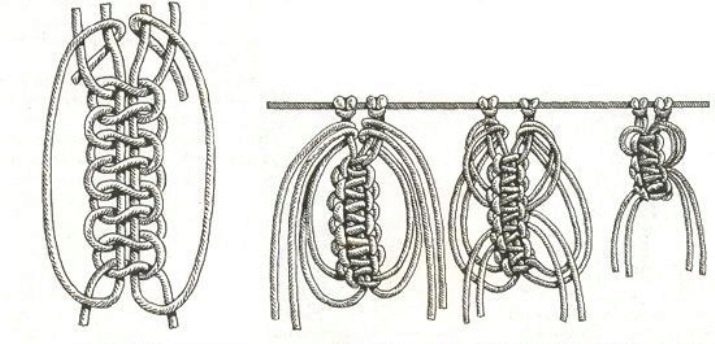
Having mastered the implementation of basic and decorative knots, you can create on your basis your own patterns of finished products, creating unique and original things.
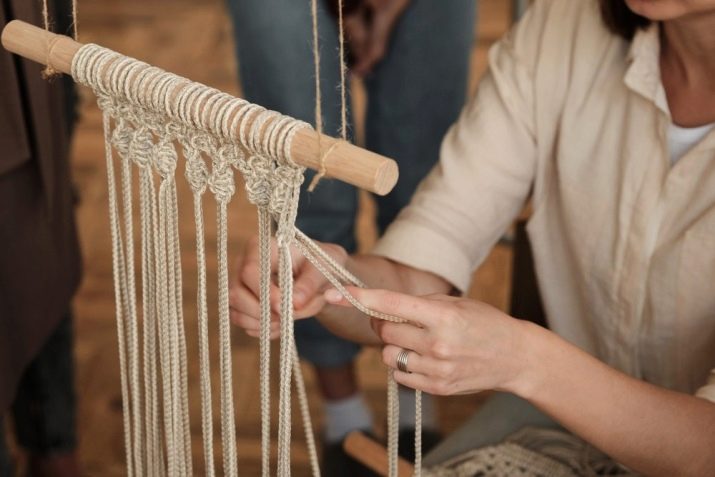
In the next video you can learn how to create a beautiful amulet using weaving.
